Day 5
Up to this point in the trip, our mornings began with a 6:30 a.m. wake-up. Today broke the rhythm. A few of us kicked off the day with a 5 a.m. run. Edwin and I completed a 3-mile loop, while Dr. Lieberman and Stanley pushed for a second lap, finishing around 7 miles.
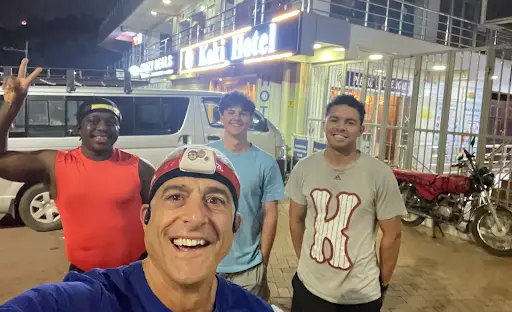
The morning running team!
After a quick recovery and breakfast, we arrived at the hospital around 7:30 a.m. and immediately began prepping for what would become our busiest surgical day so far. While each OR team set up, Dr. Hisey gave his morning lecture to the residents on spinal oncology.
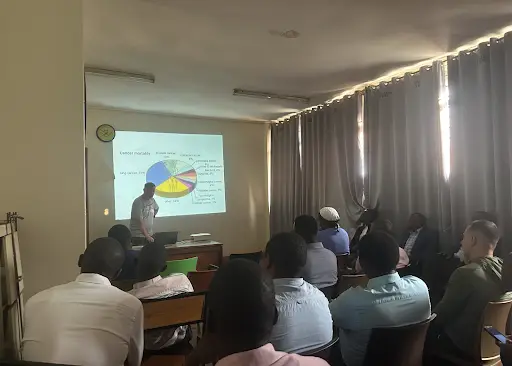
Dr. Hisey presenting his morning speech to the residents.
If the day had a theme, it was adaptability. From changing the surgical order to uncertainty with instruments, our plans were constantly evolving—but the team stayed unfazed.
Our initial lineup of cases included:
- Dr. Lieberman was operating on a patient with kyphotic deformity and pseudoarthrosis from a prior corpectomy. The procedure was a T9–L2 posterior instrumentation and fusion (PISF) with decompressions at T10/11/12.
- Dr. Hisey, treating a 38-year-old woman with spondylolisthesis at L5/S1, requiring a TLIF at L4/5 and L5/S1, followed by PISF from L4–S1.
Before surgeries began, Stanley and I joined rounds. Thanks to the structured notes we had compiled the day before, rounds flowed more smoothly. However, after reviewing the day’s cases, Dr. Lieberman felt the third case in the Spine Theatre needed to be moved up to second due to clinical urgency. So, once again, we adapted. With the revised schedule and ORs ready, we launched into the day’s cases.
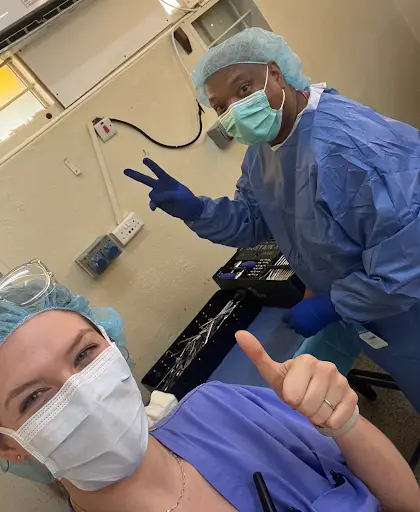
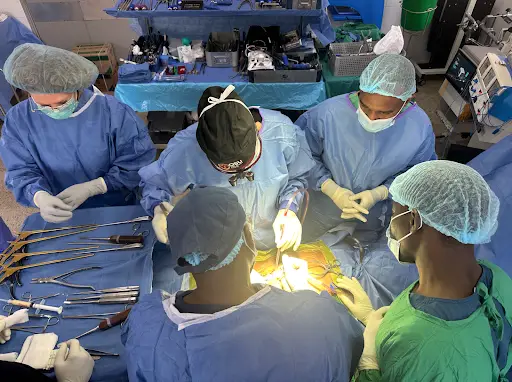
The Ward 7 team and the Spine Theatre team getting the first cases of the day underway!
After spending some time observing the operation in the Spine Theatre, Stanley and I stepped out to check on the ward and were immediately met with a surge of needs: two new walk-in patients, including a young girl who would later be diagnosed with osteosarcoma; the persistent mother of another patient pressing us to review her son’s scans; and one of our scheduled patients for later in the day, whose blood pressure had suddenly spiked. In a matter of minutes, the day shifted from smooth to chaotic. Over the next 15 minutes, Stanley calmly took control of the situation—triaging patients, giving clear direction, and restoring order. Watching him manage the moment with such clarity taught me a powerful lesson in handling urgency: prioritize quickly, delegate effectively, and always keep the patient at the center.
The first two surgeries of the day wrapped up successfully, and the next round of procedures began:
- In the Spine Theatre, a young woman with a C6/7 fracture was receiving a C6 corpectomy with reconstruction, followed by a posterior fusion from C5–C7.
- In Ward 7, a patient with a herniated disc underwent a right L4/5 microdiscectomy.
While both surgeries went well, they ran longer than expected. As a result, the third planned case in the Spine Theatre was postponed until the next morning. We spent the remainder of the day finalizing Wednesday’s surgical schedule, a process that takes a stunning amount of communication among the different teams.
But, with 4 completed cases and a schedule for the next day, the team had officially completed another successful day.
We all loaded the bus and headed back to the Koki hotel, where we enjoyed a buffet while sharing our lessons of the day before we headed up to our rooms for some much-needed rest.
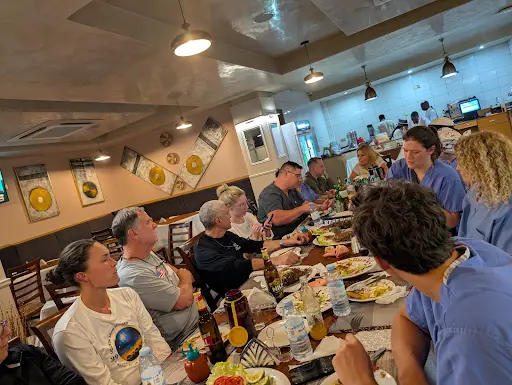
The team enjoying our nightly dinner at the Koki Hotel.
Day 6
We started the day at 5:15 a.m. with a rooftop Pilates class led by Shelby. While the city may have been quiet and peaceful at that time, the exercises were not. Instead, they were an unexpectedly challenging way to begin the day. After breakfast (featuring the newly included and delicious mangos), we loaded the bus and headed to the hospital.
By now, our team had found its rhythm. The moment we arrived, everyone moved instinctively into position—ORs were prepped, supplies checked, and roles taken on without instruction. We had reached a kind of “flow state.”
This year, we’ve been fortunate to have three guests from Ukraine join our team: Maryam (a pediatric orthopedic surgeon), Zoryana (a pediatric anesthesiologist), and Andrei (also a pediatric anesthesiologist). This morning’s lectures were given by Zoryana and Maryam.
Zoryana spoke powerfully about the challenges of providing pediatric anesthesia during wartime—highlighting an overwhelmed healthcare system, unfamiliar trauma cases, and the heartbreaking reality of treating children with complex, long-term needs. Still, she ended with hope, sharing several patient success stories, including a young double amputee who received prosthetics in the U.S. and is now back in Ukraine running marathons to raise awareness.
Maryam followed with a presentation on surgical innovation and adaptation during conflict. He described how working with limited tools and unfamiliar supplies has pushed them to develop new techniques and integrate knowledge gained abroad. Despite hardship, their hospitals are embracing creative problem-solving and even pioneering new procedures out of necessity.
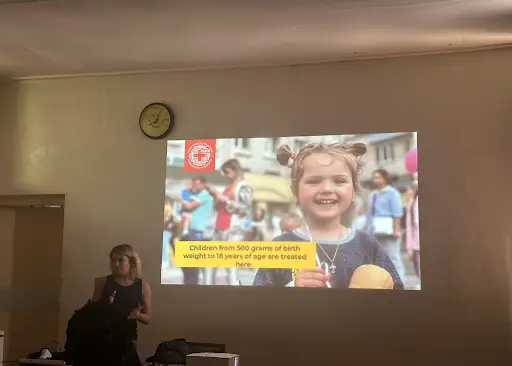
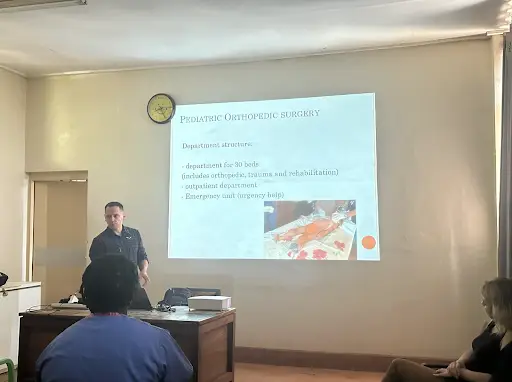
Members of both teams gathered to hear the morning speeches from Zoryana and Maryam.
After the talks, Stanley and I headed to the spine ward for rounds. Each day, these have grown faster and more streamlined. But today, we ran into a major issue—10 of our 11 remaining patients would require a C-arm (intraoperative X-ray) to complete their surgeries, and only the Spine Theatre had one available. With just two full operative days left—and Friday planned as a lighter day—we knew a solution was needed fast.
We brainstormed workarounds, including shuttling the C-arm between rooms or trying to acquire a second unit for Ward 7. Meanwhile, Stanley and I assembled a surgical priority list with detailed information: diagnosis, procedure, neurological status, social support, and input from Drs. Lieberman and Hisey. This became the foundation for Thursday’s schedule, which we finalized later that day.
While those plans took shape, two surgeries got underway:
- Dr. Hisey performed an ACDF at C5/6 on a patient who had developed a calcified herniated disc in the Spine Theatre.
- Dr. Lieberman completed T1-T6 instrumentation and T3 laminectomy decompression on a patient suffering from a metastatic lesion in Ward 7.
While the cases continued, Stanley, Brit, and I returned to the ward to collect post-op scans—and had what may have been my favorite moment of the trip so far. Two of Dr. Hisey’s patients from the day before were not only awake but walking, smiling ear to ear.
One patient, a young woman in serious pain just 24 hours prior, was now walking with her family to get her post-op X-ray—radiating relief and joy. Another patient, who had undergone a microdiscectomy, had not yet left his bed simply because no one had told him he could. As soon as Stanley let him know not only that he could move but that it was encouraged, he jumped up, did laps around the ward, and even posed for a photo with us—grinning with two thumbs up. Seeing how quickly and drastically these patients were able to improve gave us a second wind and served as a great reminder of the help we are able to provide on these trips.
With those two cases wrapped up, we moved into the afternoon operations:
- In Ward 7, I got to observe Dr. Lieberman’s thoracoplasty—a procedure to reduce a large rib hump in a young female patient.
- In the Spine Theatre, Dr. Hisey performed a lateral L2/3 interbody fusion followed by posterior instrumentation and fusion. Both cases went smoothly.
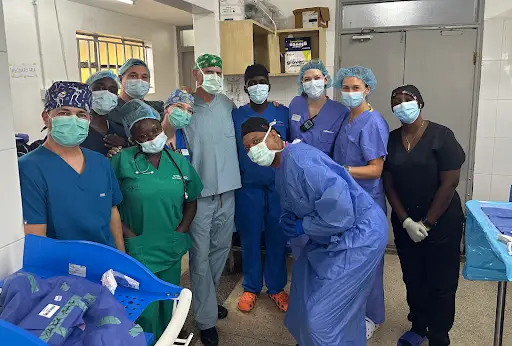
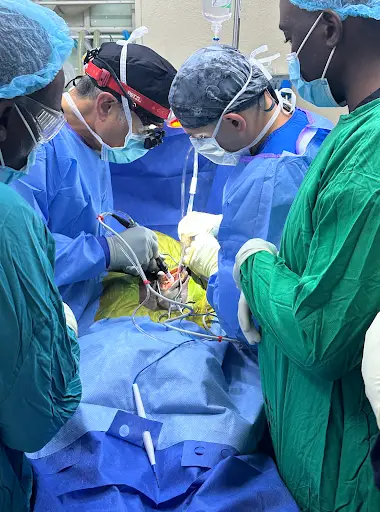
The team in the Spine Theatre celebrating a case well done, while the team in Ward 7 continues on with the thoracoplasty!
Just as the day was winding down, we got incredible news: a second C-arm was en route from New Mulago, which meant we could now operate in both ORs. We added two standby cases to Thursday’s schedule and bumped our start time to 7:00 a.m. to maximize the day.
That night at the Koki Hotel, we capped off the day with another team dinner—laughing over stories.
In a surprise twist, Dr. Lieberman asked each person to share something the team didn’t know about them. Highlights included Dr. Zvi’s secret wish to be a great singer, Edwin’s attempt to hide his motorcycle from his mom, and Dr. Lieberman’s incident at age five in which he drove an excavator into a house.
With the schedule packed and morale high, we headed to bed—ready for what would be our most ambitious day yet.

